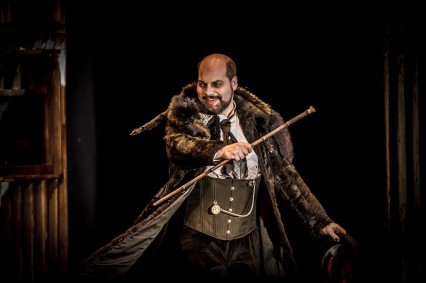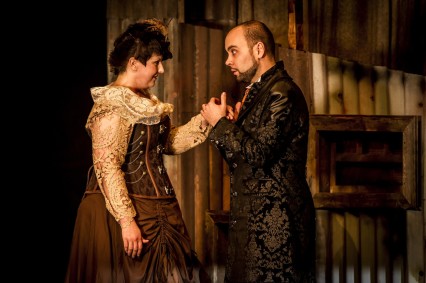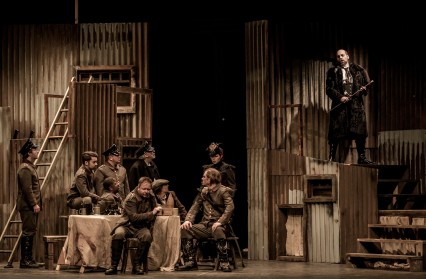Abergavenny Borough Theatre, May 6 2015
Swansea City Opera and Orchestra
Director and Set Design: Brendan Wheatley
Musical Director: John Beswick
Costume Designer: Gabriella Ingram
Cast: Angharad Morgan / Alberto Sousa / Mark Saberton / Håkan Vramsmo / Alexandra Cassidy / Caroline Carragher / Ricardo Panela
The overture to this production of Gounod’s Faust began with the restrained tones of a string quartet, and the curtain opened to the bowed figure of the elderly Faust alone on stage lamenting his fate, then from off-stage the sounds of a choir. A strong atmosphere was created from the start, which augured well for this reduced-scale touring production of the still-popular jewel of the mid-nineteenth century French operatic repertoire, sung here in English.

This is Swansea City Opera’s 10th anniversary production, and all credit to Artistic Director Brendan Wheatley for bringing opera to some of the smaller towns of Wales (and England and Scotland) on this 2015 tour – Faust has already been to Milford Haven, Pwllheli and Brecon, and goes on to Holyhead and Rhyl before reaching Swansea at the end of May. All potentially good in pursuit of the company’s laudable aim of making opera accessible and bringing it to new audiences. The people of Abergavenny and around certainly turned out in sufficient numbers to nearly fill the 338 seat Borough Theatre. However, to the best of my knowledge and observation there were no young(er) people there, which was a shame.
Given the small size of the theatre, and of the orchestra, here was an opportunity for an intimate interpretation of Faust, but this was not in the event what we got. Reduced in scale yes, but not restrained in character. So, Méphistophélès, the devil himself and villain of the piece, was here played by baritone Mark Saberton rather more in the style of a swaggering circus ringmaster than the frightening svengali figure (at least as pictures from the time show) cut by the famous Russian bass Chaliapin, one of the classic interpreters of the role at the turn of the twentieth century. Faust, played in this performance by Portuguese tenor Alberto Sousa, is clearly Méphistophélès’s puppet, but there was scope here for more subtlety in the characterisation, given the size of the playing space and the proximity of the audience.
The costume design by Gabriella Ingram is intended to convey the steampunk nature of the production, in a Victorian industrial setting, but with fantastical overtones. Unfortunately, for me, Méphistophélès’s super-shiny pointy metal shoes threatened to upstage him, and steampunk aspects of some of the other costumes looked merely slightly strange rather than adding layers of meaning to the production. Similarly, the set, built to resemble a corrugated iron Victorian city slum, served the purpose of providing an upper level for the singers, but was also sometimes distracting as the performers negotiated ladders and awkward steps.
The singing throughout was excellent from the entire company. Although there could have been more variation in volume, Angharad Morgan’s consistently rich tones throughout her vocal range, Mark Saberton’s deep resonances and Alberto Sousa’s soaring high notes were all splendid, but would have been the more so had they been matched by stronger acting. It is disappointing to see professional opera singers, still – now that the music colleges are paying more attention to the development of acting skills – sawing the air, pacing around the stage or taking hats off and putting them back on moments later for no apparent reason.

That said, there were for me stand-out performances from Swedish baritone Håkan Vramsmo as Marguerite’s soldier brother Valentin and, especially, from mezzo Alexandra Cassidy as Valentin’s friend and would-be wooer of Marguerite, Siébel. The death scene of Valentin, which risks appearing ridiculous, like all deathbed scenes in opera where a singer continues to sing heartily as he or she expires, was particularly well done. And Siébel, a man played by a woman, also always a fine line to walk in opera, was to me a totally convincing, indeed a compelling, character, combining beauty of vocal tone with first-class acting.
The orchestra, reduced to a mere eight players with John Beswick as Musical Director also helping out on keyboards, gave proficient and sympathetic support to the singers, but as all had to play throughout, they could not deliver the variety of tone colour which a larger orchestra can provide. Neither could they supply the swell of sound that the action really requires at dramatic climaxes in the action.
A feature of this production is the involvement – thanks to funding from the Arts Councils of both England and Wales – of local choirs as part of the chorus. The men of the Gwent Bach Society who joined the on-stage chorus acquitted themselves well. This opportunity was doubtless more rewarding for them than for the larger off-stage chorus, which was, apart from the section in Act One when Gounod intended them to be heard from a distance, a little too remote to be effective, and provided no more than a suggestion of the choral component of the opera.
Bringing a production of grand opera to a small theatre presents many logistical challenges, of which how to deal with the chorus is just one. Lighting is also tricky, being limited by the resources and flexibility of the particular venue, so that in Abergavenny’s Borough Theatre there were times when the singers were not ideally lit. The question is, are the inevitable compromises worth it so as to bring opera to audiences who would not otherwise have a chance to see and hear it? Swansea City Opera, as a touring company, sits between what is offered by local amateur groups and the big opera companies. We have to be grateful that, for now at least, funding enables it to continue, particularly as Mid-Wales Opera has been forced to cancel its planned 2015 autumn tour of Rossini’s The Barber of Seville because of funding problems. And it is wonderful that small towns can offer opera to people on their doorsteps. Would that funding had permitted an additional matinée performance in Abergavenny for local schools. The clear education pack supplied by the company really needs students to come and see the performance for the material in it be brought to life.
The star of this show was Gounod’s music, by turns lyrical, reflective and stirringly rhythmic, and always tuneful. It is an ideal introduction to opera for anyone who has not heard any before. I did, however, wish that we could have magically enlarged the Borough Theatre so as to have had a full chorus on stage, with the swirl of the waltz, the bustle of the inn, the terror of the demons on Walpurgis Night, and a full orchestra to bloom and carry us all away with the drama. As it was we must be grateful that we have touring opera at all, and that people like Artistic Director Brendan Wheatley are prepared to devote themselves to continuing to bring it around Wales.
Further details about the tour can be found at http://www.swanseacityopera.com/
Photographs by Guy Harrop



 Enjoyed this article? Support our writers directly by buying them a coffee and clicking this link.
Enjoyed this article? Support our writers directly by buying them a coffee and clicking this link.







